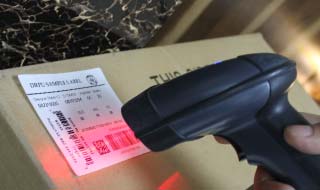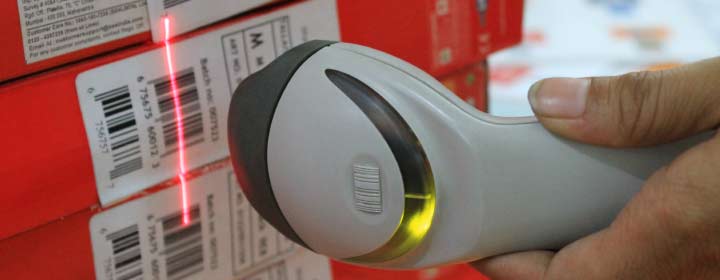Barcode Scanner
Barcode scanners come in a variety of types and form factors, including handheld scanners, fixed mount scanners, and mobile devices with built-in barcode scanners. Handheld scanners are the most common type and are often used in retail, healthcare, and logistics applications. Fixed mount scanners are used in automated production and assembly lines, while mobile devices with built-in scanners are used in inventory management and field service applications.
Posted By: Techsavvy
|Updated on: 30/03/2023
Major Points of Barcode Scanner:-

- A barcode scanner, also known as a barcode reader, is an electronic device that is used to read and decode barcodes. The scanner uses a laser or camera to capture the barcode image, and then processes the image to extract the information contained within the barcode.
- Barcode scanners can decode a wide range of barcode types, including linear barcodes such as Code 39 and Code 128, as well as 2D barcodes such as QR codes and Data Matrix codes. Some advanced scanners can also read barcodes from digital displays, such as those found on mobile phones and computer screens.
Different Types of Barcode Scanner:-
Laser barcode scanners use a laser beam to read the barcode. The scanner emits a laser beam that is reflected off the barcode and detected by a photodiode. The scanner then interprets the pattern of the reflected light to decode the barcode. Laser scanners can read barcodes from a distance and are best suited for scanning linear barcodes.
Linear imager barcode scanners, also known as CCD scanners, use a charged coupled device (CCD) to read the barcode. The scanner takes a series of images of the barcode and interprets the pattern of the light reflected from the barcode to decode it. Linear imagers are best suited for scanning low-density barcodes and are more durable than laser scanners.
2D barcode scanners use image capture technology to read and decode 2D barcodes such as QR codes and Data Matrix codes. The scanner captures an image of the barcode and uses software to decode the information stored within it. 2D scanners can read barcodes in any orientation and can store more information than linear barcodes.
A handheld barcode scanner is a portable device that is designed to be held by the user and manually pointed at the barcode to read it. Handheld scanners are ideal for applications that require mobility and flexibility, such as retail stores, warehouses, and distribution centers.
A stationary barcode scanner is a fixed device that is mounted on a stand or built into a fixed position. Stationary scanners are designed to read barcodes as they pass by on a conveyor belt or other automated system. They are typically used in high-volume manufacturing and distribution operations where a high level of automation is required.
Different Factors When Choosing a Barcode Scanner:-
When choosing a barcode scanner, here are some factors you may want to consider:
-
Scanning Speed:
Consider the scanning speed required for your application, especially if you need to scan multiple barcodes quickly and efficiently, and choose a scanner that can meet the required speed.
-
Interface:
Choose a scanner that has an interface that is compatible with your existing hardware and software, such as USB, RS-232, or Bluetooth, and that can be easily integrated into your system.
-
Durability:
Consider the durability of the scanner, especially if it will be used in a harsh environment, and choose a scanner that is designed to withstand drops, impacts, and exposure to dust, water, or chemicals.
-
Price:
Consider the price of the scanner, as well as the cost of ownership over its lifespan, and choose a scanner that provides good value for your budget.
-
Type of Barcode:
Consider the type of barcode symbology that you will be scanning, such as UPC, Code 39, Code 128, or QR code, and choose a scanner that is compatible with the symbology.
-
Scanning Distance:
Determine the scanning distance needed for your application, whether it is short-range, mid-range, or long-range, and choose a scanner that can scan barcodes from the required distance.
-
Corded or Cordless:
Decide whether you need a corded or cordless scanner, depending on your application and mobility requirements.
-
Ergonomics:
Look for a scanner that is comfortable to hold and use, with an ergonomic design that reduces fatigue and strain on the user.

Overall, the factors to consider when choosing a barcode scanner depend on the specific application and environment where the scanner will be used. It's important to evaluate different options, test the scanners with your system and barcodes, and consult with experts to ensure that the scanner meets your requirements and provides accurate and reliable scanning.
Integrate Barcode Scanner with Hardware and Software Application:-
Integrating a barcode scanner with your existing hardware and software applications can be done in several ways, depending on the type of scanner and hardware and software you are using and you can automate data entry and reduce errors caused by manual data entry. This can help you save time, improve accuracy, and increase productivity in your business. Here are some general steps you can follow:
-
Check the Compatibility of the Barcode Scanner:
Before integrating the barcode scanner with your hardware and software applications, make sure that the scanner is compatible with your hardware and software applications. Check the technical specifications of the scanner and your hardware and software documentation to ensure compatibility.
-
Configure the Scanner:
Depending on the integration method you choose, you may need to configure the scanner to work with your hardware and software applications. This may involve setting up the scanner to use a specific emulation mode and API or configuring the scanner to send data in a particular format.
-
Choose the Integration Method:
There are several ways to integrate a barcode scanner with your hardware and software. The most common methods are:
-
Keyboard Emulation:
The scanner is configured to act like a keyboard, and when it scans a barcode, the scanner sends the barcode data to the computer as if it were typed in by a keyboard.
-
Serial Port Emulation:
The scanner is configured to act like a serial device, and when it scans a barcode, the scanner sends the barcode data to the computer via a serial port.
-
USB Emulation:
The scanner is configured to act like a USB device, and when it scans a barcode, the scanner sends the barcode data to the computer via a USB port.
-
Software Development Kit (SDK):
Some manufacturers provide a software development kit that includes a library of functions that can be used to integrate the scanner with the software application.
-
Application Programming Interface (API):
Some scanners come with an API that allows software developers to integrate the scanner with their applications. The API provides programming instructions to enable the scanner to communicate directly with the software application
-
Install the Scanner Drivers:
Most barcode scanners require drivers to be installed on the computer to work properly. Install the drivers that come with the scanner or download the latest version from the manufacturer's website.
-
Test the Integration:
Once the scanner is configured, test the integration to ensure that the barcode data is being transmitted correctly to your hardware and software applications.
Barcode Scanner Support Options:-
If you have questions or issues with your barcode scanner, there are several support options available depending on the manufacturer and model of your scanner. Here are some common support options:
Online Forums and Communities: There are several online communities and forums dedicated to barcode scanners and related technologies. You can search for these forums and communities using a search engine, and post your questions or issues to get advice from other users.
Email and Phone Support: Many manufacturers offer email and phone support for customers who need assistance with their barcode scanners. You can find the contact information for customer support on the manufacturer's website or in the user manual.
Manufacturer's Website: Most manufacturers have a support section on their website that includes FAQs, troubleshooting tips, and contact information for customer support.
User Manual: Most barcode scanners come with a user manual that includes troubleshooting tips and contact information for customer support.
Live Chat: Some manufacturers offer live chat support on their website, allowing you to get real-time assistance from a customer support representative.
Service Centers: If your barcode scanner needs repairs or maintenance, you may be able to take it to a service center authorized by the manufacturer.
Technical Support Services: Many manufacturers offer technical support services that can help you troubleshoot issues with your scanner. These services may be available for free or for a fee, depending on the manufacturer and the level of support you need.
Retailer Support: If you purchased your barcode scanner from a retailer, you may be able to contact them for support. They may be able to assist you with troubleshooting or provide you with contact information for the manufacturer's support team.
Troubleshoot the Issues With My Barcode Scanner:-
If you're experiencing issues with your barcode scanner, here are some steps you can take to troubleshoot the problem:
-
➲ Check the Connections
Ensure that the scanner is properly connected to the device you are using it with (such as a computer or mobile device) and that the cables are not damaged or loose.
-
➲ Check the Battery
If you are using a wireless scanner, make sure the battery is charged and properly inserted into the scanner.
-
➲ Check the Scanner Settings
Ensure that the scanner is set up correctly for the type of barcodes you are scanning. Some scanners may have settings for the type of barcode, the length of the barcode, or the specific application you are using.
-
➲ Check the Barcode
Make sure the barcode you are scanning is not damaged or smudged. Clean the barcode if necessary.
-
➲ Test the Scanner
Test the scanner with a different barcode to see if the issue persists.
-
➲ Restart the Device
If the problem persists, try restarting the device you are using the scanner with.
-
➲ Contact Customer Support
If none of the above steps solve the issue, contact the manufacturer's customer support for further assistance.
By following these steps, you can troubleshoot issues with your barcode scanner and get back to using it efficiently.